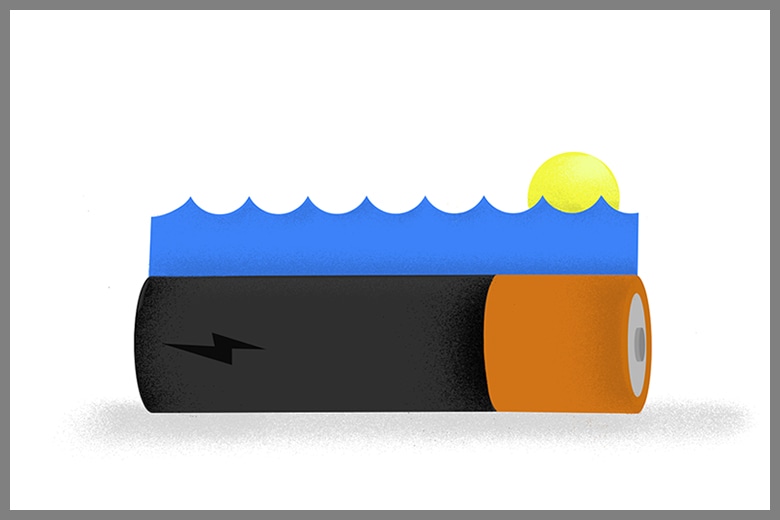Nov 1 2016
 Stanford engineers set an efficiency record with an experimental technology that stores solar energy in a process that uses water as a battery. (Image credit: Stefani Billings)
Stanford engineers set an efficiency record with an experimental technology that stores solar energy in a process that uses water as a battery. (Image credit: Stefani Billings)
Solar energy is capable of providing abundant power only if two major issues are solved by scientists. These issues include making the technology more cost effective, and storing the energy for use at all hours. An interdisciplinary team at Stanford has recently made two significant strides in solving the storage issue, and illustrating the extremely efficient means for storing electricity captured from sunlight in the form of chemical bonds. Discovering a way to bring down the cost of their technology will indeed be a great achievement by researchers aiming to make solar power a feasible alternative to current, more polluting energy sources.
The fundamental science executed by the team highlights the usage of electricity captured from sunlight in order to split water molecules into oxygen gas and hydrogen. The solar energy can be recovered by a variety of ways. For example, by recombining the oxygen and hydrogen into water for releasing electricity again, or by burning the hydrogen gas in an internal combustion engine, which is similar to those currently working on petroleum products.
Even though the method is easily understood, the challenge exists in turning this science into an effective industrial process. This is where a major improvement was brought about by a team headed by Thomas Jaramillo, an associate professor of chemical engineering and of photon science, and James Harris, a professor of electrical engineering. Nature Communications has published a work in which these researchers were able to capture and store 30% of the energy captured from sunlight into stored hydrogen, beating the earlier record of 24.4%.
This milestone brings us much closer to a sustainable and practical process to use water-splitting as a storage technology. Improving efficiency has a remarkable impact on lowering costs. We have to continue work on finding more ways to lower the costs to compete with conventional fuels.
Thomas Jaramillo, an associate professor of chemical engineering and of photon science
Improved energy storage
The researchers initially used a solar cell in their experiments. This cell is highly expensive and extremely different when compared to the standard rooftop solar arrays. Standard rooftop arrays are based on silicon, however, the Stanford team used solar cells pioneered by Harris’ lab that employed three less-common semiconductor materials. These less popular semiconductor materials are known as triple-junction solar cells due to the fact that each material is tuned to capture red, green or blue light, respectively. Through this precision, triple-junction solar cells transform 39% of incoming solar energy into electricity, compared with approximately 20% for silicon-based, single-junction solar cells discovered on rooftops all over the world.
However, one significant question for the researchers was not on how energy was captured but on how much energy was stored through water splitting. Jaramillo and his collaborators, solved this question by further developing on a research they have conducted on how to enhance the performance of catalysts, which are materials that speed up chemical reactions but are not consumed in the process. The team stored electricity captured from sunlight by looking specifically at water-splitting catalysts, in which electrons travel through the catalytic materials in order to break apart the steady H2O molecule.
A great deal of the catalytic process in the Stanford experiment is built on the earlier improvements in the area, with one specifically important approach to obtain their record energy capture. A single electrolysis device is mostly used by photovoltaic-powered water-splitting reactions, but the team was able to merge two identical electrolysis devices in such a manner to develop twice as much hydrogen, making use of their higher-efficiency solar cells and setting them to work.
Tuning all the elements, electronics and the chemistry was critical. The entire system has to be perfectly balanced or the process wouldn’t work at all.
James Harris, a professor of electrical engineering
The obtained measurements highlighted that 30% of the energy initially collected by the triple-junction solar cells had been stored in the form of hydrogen gas.
Addressing costs
The Stanford researchers have thus demonstrated this record-setting efficiency in the use of water-splitting in order to store sun power. They next shift their focus on costs: the triple-junction solar cells and catalysts used, which also included platinum, are ideal for proof-of-principle experiments but not for an industrial process. “But what we’ve done is demonstrate how a systems approach can vastly improve storage efficiency,” Jaramillo said. “Now we have to find ways to get similar results with less expensive materials and devices.”
According to Jaramillo and Harris, one major reason behind the success of this research refers to the teamwork between different scientists and engineers. The team used 11 researchers, including collaborators from the SLAC National Accelerator Laboratory and experts in electronics, process engineering and chemistry in order to achieve two goals. The first goal deals with squeezing the utmost in power from sunlight, and then storing much of this as possible through water-splitting chemistry.
It took specialists in different fields to do what none of us could have done alone. That’s one of the lessons of this result: There is no single fix. How everything links together is the key.
James Harris, a professor of electrical engineering
Harris is also the James and Elenor Chesebrough Professor in the School of Engineering, professor, by courtesy, of applied physics and of materials science and engineering, an affiliate of the Precourt Institute for Energy and the Stanford Woods Institute for the Environment, and a member of Stanford Bio-X and of the Stanford Neurosciences Institute. Jamarillo is also an affiliate of the Precourt Institute for Energy.